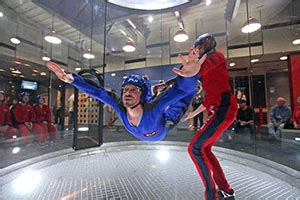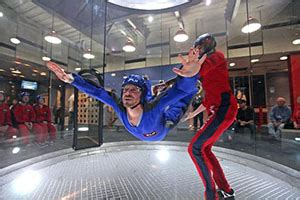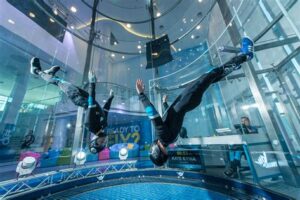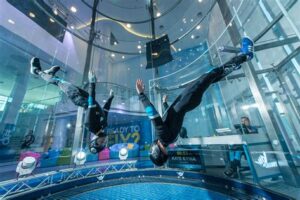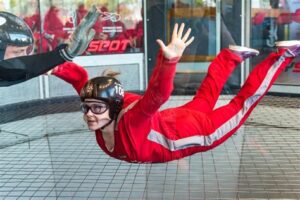Table of Contents
Indoor skydiving safety is of utmost importance for thrill-seekers and enthusiasts. Discover the essential measures, equipment, and protocols practiced in indoor skydiving facilities to ensure a secure and enjoyable experience. From trained instructors to state-of-the-art wind tunnels, explore the world of safe and exhilarating indoor skydiving.
Indoor skydiving, also known as vertical wind tunnel flying, is an exhilarating experience that allows individuals to simulate the sensation of freefall without jumping out of a plane. However, just like any adventure sport, safety should always be the top priority. In this article, we will delve into the world of indoor skydiving safety, providing you with essential guidelines and precautions to ensure a smooth and secure flight. So, fasten your seatbelts and get ready to soar through the sky, knowing that you are in safe hands.
Introduction
Welcome to the world of indoor skydiving, a thrilling experience that allows you to feel the rush of freefall without jumping out of an airplane. While indoor skydiving is a safe and controlled activity, it is important to follow certain safety precautions to ensure a fun and secure experience. In this article, we will provide you with essential instructions and guidelines to maximize your safety during indoor skydiving sessions.
Wear Appropriate Clothing
Before entering the wind tunnel, it is essential to wear appropriate clothing. Loose or baggy attire can get caught in the airflow, leading to potential hazards. It is recommended to wear tight-fitting clothes, such as athletic wear or jumpsuits provided by the facility. Avoid wearing jewelry, belts, or accessories that could potentially become loose during the flight.
Listen to the Instructor
Paying attention to your instructor is crucial in ensuring your safety during indoor skydiving. They will provide you with important information about body positioning, hand signals, and safety procedures. Follow their instructions carefully and ask any questions you may have before entering the wind tunnel.
Proper Body Positioning
Maintaining the correct body position is vital for stability and control during indoor skydiving. Keep your body straight, with arms extended forward and legs slightly bent. Avoid arching your back or bending at the waist, as it can disrupt balance and stability. Listen to your instructor’s guidance on body positioning and make adjustments accordingly.
Follow Hand Signals
During your flight, the instructor will communicate with you using hand signals. These signals are essential for maintaining safety and receiving guidance while inside the wind tunnel. Familiarize yourself with common hand signals, such as relax, straighten up, or bend your legs. Respond promptly to these signals to ensure a smooth and secure experience.
Be Aware of the Wind Speed
The wind speed inside the tunnel can vary depending on your skill level and preferences. Beginners should start with lower wind speeds to get accustomed to the sensation of freefall. As you gain experience, gradually increase the wind speed. However, always stay within your comfort zone and avoid pushing yourself beyond your limits.
Stay Hydrated
Indoor skydiving can be physically demanding, and it is essential to stay hydrated throughout your session. Drink plenty of water before, during, and after your flights to prevent dehydration. Avoid consuming excessive amounts of caffeine or alcohol, as they can dehydrate your body and affect your performance.
Know Your Physical Limitations
Understanding your physical limitations is crucial for your safety during indoor skydiving. If you have any pre-existing medical conditions or injuries, consult with a healthcare professional before participating. Inform your instructor about any limitations or concerns you may have, as they can provide tailored guidance to ensure a safe and enjoyable experience.
Respect Personal Space
When inside the wind tunnel, it is essential to respect the personal space of others. Avoid colliding or getting too close to fellow flyers, as it can lead to accidents or injuries. Maintain a safe distance and be mindful of your surroundings to ensure a smooth and secure environment for everyone.
Follow Emergency Procedures
While indoor skydiving is generally safe, it is essential to be familiar with the facility’s emergency procedures. In case of any unexpected situations, follow the instructions provided by the instructors or staff. They are trained to handle emergencies and will guide you through the necessary steps to ensure your safety.
Conclusion
By following these instructions and guidelines, you can enjoy the thrilling experience of indoor skydiving while prioritizing your safety. Remember to wear appropriate clothing, listen to your instructor, maintain proper body positioning, and be aware of your surroundings. With these precautions in mind, you can have a fantastic time flying in the wind tunnel with confidence and peace of mind.
Indoor Skydiving Safety: Use Instructions
When participating in indoor skydiving, your safety should always be a top priority. By following the provided instructions and being mindful of your surroundings, you can have a thrilling and secure experience. Here are some essential guidelines to ensure your indoor skydiving safety:
1. Wearing the Appropriate Gear
Before entering the wind tunnel, it is crucial to wear the appropriate gear. The jumpsuit, helmet, goggles, and earplugs provided are designed to enhance your safety. Make sure the jumpsuit fits snugly but still allows for comfortable movement. Ensure that the helmet is securely fastened to provide maximum protection.
2. Properly Fastening the Harness
Prior to entering the wind tunnel, an instructor will assist you in putting on and correctly fastening the harness. It is vital to follow their guidance and ensure that all buckles and straps are tightly secured. This will keep you safely positioned during your flight and prevent any unexpected movements or accidents.
3. Listening and Following Instructions
Pay close attention to the instructor’s pre-flight briefing and carefully follow their instructions. They will guide you on body positioning, hand signals, and how to maneuver in the wind tunnel. By attentively listening and following their guidance, you will maintain a safe and enjoyable experience.
4. Maintaining Proper Body Position
Inside the wind tunnel, it is crucial to maintain the correct body position to ensure stability and safety. Keep your body relaxed, with slightly bent arms and knees. This position will help stabilize your flight and prevent any unwanted spinning or tumbling.
5. Being Mindful of Airflow
Indoor skydiving relies on powerful air currents, so it is essential to be aware of the airflow within the tunnel. Listen for any changes in airflow and react accordingly by adjusting your body position to maintain control. This heightened awareness will enhance your safety and overall experience.
6. Avoiding Loose Objects and Jewelry
Prior to entering the wind tunnel, remove all loose objects, including jewelry and watches. These items can become safety hazards if caught in the wind tunnel’s airflow. By eliminating potential risks, you protect yourself and others participating in the activity.
7. Listening to Your Body
While indoor skydiving is generally safe, it is crucial to listen to your body and be aware of any discomfort or fatigue. If you experience pain or dizziness during the flight, immediately inform the instructor and request assistance. Your well-being is paramount, and the instructor will guide you through the necessary steps to address any concerns.
8. Following Emergency Procedures
Although emergencies are unlikely, it is essential to familiarize yourself with the emergency procedures provided by the instructor during the pre-flight briefing. In the event of an emergency, remain calm and follow their instructions carefully to ensure a swift and safe resolution.
Remember, safety is of utmost importance during indoor skydiving. By following these instructions and being attentive to your surroundings, you can have an exhilarating and enjoyable experience while minimizing any potential risks.
Indoor skydiving safety is of utmost importance to ensure a thrilling yet secure experience for all participants. In order to effectively communicate the safety instructions, it is crucial to consider the voice and tone used in the instructions. Here is a point of view on how the instructions should be presented:
-
Clear and concise: The safety instructions should be written in a straightforward and unambiguous manner, using simple language that can be easily understood by individuals of all ages and backgrounds. This will ensure that participants comprehend the safety guidelines without any confusion or misinterpretation.
-
Authoritative: The voice used in the instructions should convey a sense of authority and expertise. This will help establish credibility and reassure participants that the safety guidelines are designed by professionals who have a deep understanding of the activity and its associated risks.
-
Informative: The tone of the instructions should be informative and educational, providing participants with all the necessary information they need to engage in indoor skydiving safely. It should highlight potential risks, explain the safety measures in place, and emphasize the importance of following the instructions precisely.
-
Reassuring: It is essential to maintain a reassuring tone throughout the instructions. Participants may naturally feel anxious or nervous about the activity, especially if it is their first time. By using a calm and supportive tone, the instructions can help alleviate any apprehensions and build confidence among participants.
-
Encouraging: The voice and tone should also be encouraging, motivating participants to embrace the adventure while adhering to the safety guidelines. By highlighting the benefits of following the instructions and emphasizing the incredible experience that awaits them, participants will be more inclined to take safety seriously.
-
Positive: Lastly, the overall voice and tone of the instructions should remain positive. Instead of focusing solely on potential risks, the instructions should highlight the safety measures in place and the fun-filled nature of indoor skydiving. This positive outlook will create a more enjoyable and engaging experience for the participants.
In conclusion, when designing the safety instructions for indoor skydiving, it is crucial to use a clear, authoritative, informative, reassuring, encouraging, and positive voice and tone. By doing so, participants will have a better understanding of the safety guidelines and feel confident in their ability to have a safe and thrilling indoor skydiving experience.
Thank you for taking the time to visit our blog and learn more about indoor skydiving safety. We understand that this thrilling activity can be a great source of excitement and adrenaline, but it is important to prioritize safety above all else. In this closing message, we would like to emphasize some key points that we have discussed throughout the article.
First and foremost, it is crucial to follow all the instructions and guidelines provided by the trained professionals at the indoor skydiving facility. These experts are there to ensure your safety and guide you through the experience. Pay close attention to their instructions regarding body position, hand signals, and how to control your movements during the flight. It is essential to listen carefully and ask questions if you are unsure about anything. Remember, the more knowledge you have, the safer your indoor skydiving experience will be.
Furthermore, maintaining a proper physical condition is vital for your safety during indoor skydiving. While it may seem like a low-impact activity, it still requires a certain level of fitness and flexibility. Make sure you inform the staff about any pre-existing medical conditions or injuries that might affect your ability to participate in this activity. Additionally, warm-up exercises and stretching before the flight can help prevent muscle strains or injuries. By taking care of your physical well-being, you can minimize the risks associated with indoor skydiving.
In conclusion, indoor skydiving can be an incredibly exhilarating experience, but it is essential to approach it with caution and prioritize safety. Always adhere to the instructions given by the professionals, as they have the expertise to ensure your well-being throughout the flight. Additionally, taking care of your physical condition and being aware of any limitations or medical conditions is crucial. By following these guidelines and being mindful of safety precautions, you can enjoy the thrill of indoor skydiving while minimizing the risks involved. We hope this article has provided you with valuable information and encourages you to embark on a safe and unforgettable indoor skydiving adventure. Happy flying!
Video Indoor Skydiving Safety
People Also Ask about Indoor Skydiving Safety:
-
Is indoor skydiving safe?
Yes, indoor skydiving is considered a safe activity. The wind tunnels used for indoor skydiving are designed with safety in mind and have multiple safety measures in place to ensure the well-being of participants.
-
What are the risks involved in indoor skydiving?
While the risks associated with indoor skydiving are minimal, there is a possibility of minor injuries such as bruises or muscle strains if proper instructions are not followed. However, these incidents are rare, and the trained instructors will guide you on how to avoid any potential risks.
-
Do I need any prior experience to try indoor skydiving?
No prior experience is required to try indoor skydiving. Indoor skydiving facilities provide thorough training sessions where certified instructors teach you the necessary techniques and safety procedures. They will guide you throughout the entire process, ensuring a safe and enjoyable experience for everyone.
-
Are there any age or health restrictions for indoor skydiving?
The age and health restrictions may vary depending on the facility. Generally, children as young as 3 years old can participate in indoor skydiving, while there might be some height and weight restrictions. It’s recommended to check with the specific facility beforehand to ensure compliance with their regulations.
-
What safety equipment is provided during indoor skydiving?
Indoor skydiving facilities provide all the necessary safety equipment, including a jumpsuit, helmet, goggles, and earplugs. These items are designed to protect you and enhance your experience by minimizing any potential risks.
Remember, indoor skydiving is a thrilling and safe activity when performed under the guidance of trained professionals. Follow the instructions provided by the instructors, adhere to safety guidelines, and enjoy an exhilarating experience in a controlled environment.

